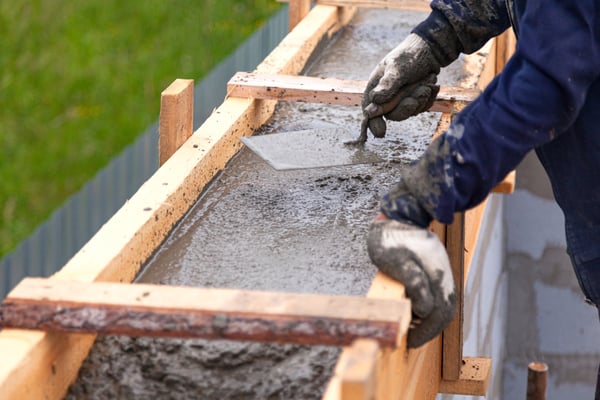What Is Self-Compacting Concrete?

Self-compacting concrete, also known as self-consolidating concrete, is characterized by its high fluidity. Thanks to this property, it spreads into concrete formwork with no need for vibration equipment. This non-segregating concrete is distributed by its own weight, while maintaining the properties of regular concrete, such as durability and strength.
Some self-compacting concrete mixtures include admixtures like superplasticizers and viscosity modifiers to reduce bleeding and segregation. When concrete segregates, it loses strength and results in honeycombed areas throughout the surface. However, a well-designed self-compacting concrete will not segregate thanks to its plasticity and stability.
Get professional construction management services for your next project.
Self-Compacting Concrete Materials
The materials used to create a self-compacting concrete mixture are the following:
Portland Cement: Common Portland cement grade 43 or 53 is commonly used.
Aggregates: The size of coarse aggregate is limited to 20 mm, but in the case of having a structure with congested reinforcement, the aggregate size can range between 10 to 12 mm. Well-graded round or cubical aggregates are recommended for best performance. The fine aggregates can be natural or manufactured with a uniform grade, usually with a size smaller than 0.125 mm.
Water: Water is treated the same way as regular concrete.
Mineral Admixtures: This may vary according to the mix design and the properties required. Below is a list of the different mineral admixtures used, and the properties they provide to the concrete mixture:
- Fly ash: Used to improve the filling of the internal concrete matrix, resulting in fewer pores. This reduces permeability and improves the quality of structures.
- Ground granulated blast furnace slag (GGBS): GGBS helps improve the rheological properties of concrete.
- Stone Powder: Incorporated to improve the powder content of the mixture.
- Silica Fumes: Used to improve the mechanical properties of the structure.
Chemical Admixtures: As mentioned before, superplasticizers are commonly used in self-compacting concrete. Air entraining agents are used to improve the freezing and thawing resistance of the structure. Retarders are employed to control the setting time of concrete.
Self-Compacting Concrete Properties

Self-compacting concrete is resistant to segregation, thanks to the presence of mineral fillers and special admixtures. As mentioned earlier, this type of concrete must have high fluidity and be able to fill special forms under its own weight without mechanical vibration. It also must be fluid enough to pass around congested reinforced areas within structures, and most importantly avoid any segregation (honeycombing). There are cases in which self-compacting concrete has been placed at heights above 5 meters, without presenting any aggregate segregation.
Self-compacting concrete with a similar water-cement ratio as traditional vibrated concrete will have a slightly higher strength, due to the lack of vibration. This improves the interface between the aggregate and the hardened paste. It is important to note that self-compacting concrete must be poured faster than regular concrete.
Applications of Self-Compacting Concrete
The main applications of this type of concrete are the following:
- Construction of raft and pile foundations
- Retrofitting and repairing constructions
- Structures with complex reinforcement distributions
- Construction of earth retaining systems
- Drilled shafts
- Columns
Advantages of Self-Compacting Concrete
Self-compacting concrete comes with several advantages compared with regular concrete. Some of these benefits include:
- Fast placement without mechanical consolidation.
- Improved constructability.
- Reduces permeability in concrete structures.
- Minimizes voids in highly reinforced areas.
- Eliminates problems associated with concrete vibration.
- Creates high-quality structures with improved structural integrity.
- High durability, strength, and reliability.
- Reduces labor costs.
- Allows for innovative architectural features, since it can be used in complex forms.
- Creates smoother and more aesthetic surface finishes.
- Allows easier pumping, and there are many placement techniques available.
Disadvantages of Self-Compacting Concrete:
As with any construction material, self-compacting concrete faces the following limitations:
- Material selection is more strict.
- Construction costs increase, compared with regular concrete.
- Many trial batches and laboratory tests are required to use a designed mixture.
- Higher precision is required when measuring and monitoring.
- There is no internationally accepted test standard for self-compacting concrete mix.
Special Considerations When Using Self-Compacting Concrete
When using this type of concrete, there are several special considerations to achieve the best results. First of all, the production of self-compacting concrete requires more experience and care than regular vibrated concrete. Also, the formwork used must be designed to withstand a higher pressure than with regular concrete. Finally, using mixers at full capacity is not recommended due to the high fluidity of self-compacting concrete - it may spill along the road, causing contamination.
Nearby EngineersNew York Engineers has a MEP design track record of 1,000+ projects. Contact us via email (info@ny-engineers.com) or phone, and make sure your building systems meet codes.

Keith Fink
Keith is the Franchise Brand Manager at NY Engineers, Keith is all things related to our project portfolio, brands and all things you need to know before we start your project.
Join 15,000+ Fellow Architects and Contractors
Get expert engineering tips straight to your inbox. Subscribe to the NY Engineers Blog below.
